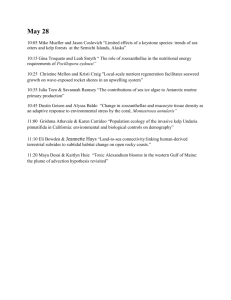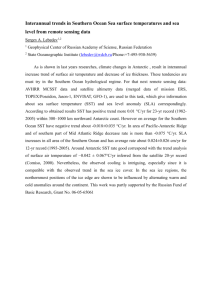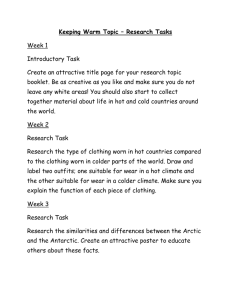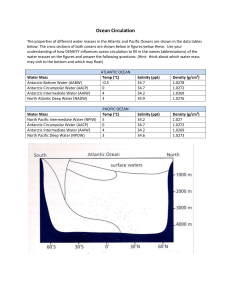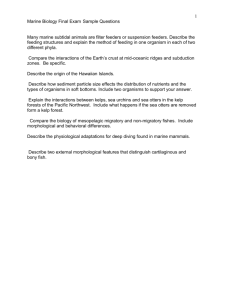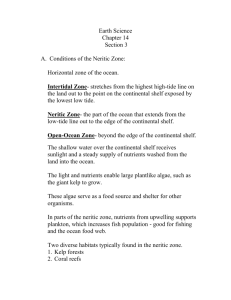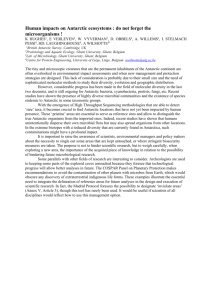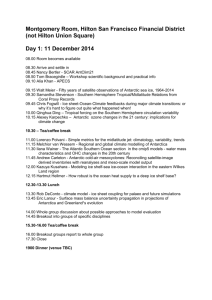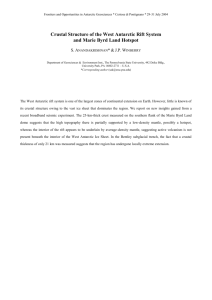Polar & Kelp - Shanghai American School
advertisement
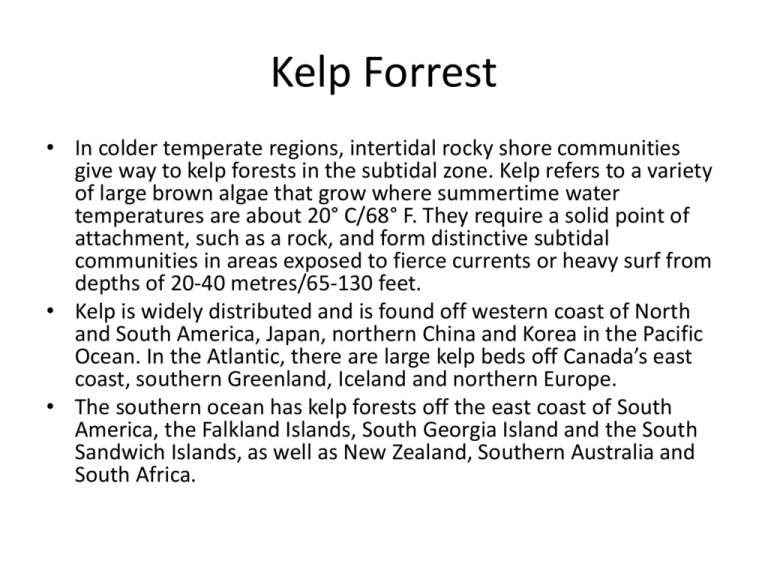
Kelp Forrest • In colder temperate regions, intertidal rocky shore communities give way to kelp forests in the subtidal zone. Kelp refers to a variety of large brown algae that grow where summertime water temperatures are about 20° C/68° F. They require a solid point of attachment, such as a rock, and form distinctive subtidal communities in areas exposed to fierce currents or heavy surf from depths of 20-40 metres/65-130 feet. • Kelp is widely distributed and is found off western coast of North and South America, Japan, northern China and Korea in the Pacific Ocean. In the Atlantic, there are large kelp beds off Canada’s east coast, southern Greenland, Iceland and northern Europe. • The southern ocean has kelp forests off the east coast of South America, the Falkland Islands, South Georgia Island and the South Sandwich Islands, as well as New Zealand, Southern Australia and South Africa. • Since kelp is an algae (not a flowering plant as found on land) they don’t have roots, but attach to the bottom by holdfasts. • Similarly, stipe and blade are used to describe the stalk and leaf, respectively. Some kelps also have pneumatocysts, or gas-filed floats, which keep the blades near the surface of the water where they can photosynthesize. These kelp communities are highly pro-ductive because they have a large surface area for photosynthesis and there is a constant nutrient supply from the turbulent water. • Kelps are the largest of all algae and are among the fastest growing plants on earth. Most kelps grow from six to 25 centimetres/2.5 to 10 inches per day, but giant kelp (Macrocystis pyrifera) can grow as much as 50-60 centimetres/20-24 inches daily. • As with many other algae, kelps have a complex life cycle with two alternating generations. During the asexual phase, in which no male or female germ cell is produced, an adult sporophyte forms. Sporophyte offspring initiate the sexual reproductive phase by producing male and female gametes (equivalent to sperm and eggs). Asexual sporophytes quickly colonize a bare surface and develop into adults. • During sexual reproduction, male and female gametes fuse to form a fertilized egg called a zygote. Sexual reproduction takes large amounts of energy, but the long-term evolutionary benefit is mixing of genes. Bull Kelp life cycle: A) Spores are released from the adult plant. B) Spores develop into sperm or eggs. C) Fertilization is external and the embryo settles to the bottom. D) The embryo grows into the adult sporophyte stage. • Kelp forests are extremely productive areas and the community in Alaska, USA’s Aleutian Islands supported the Stellar sea cow (Hydrodamalis gigas). This gargantuan herbivore was the largest of all modern sirenia (the order that includes manatees and dugong), reaching eight metres/26 feet in length. But hunting by Russian fur traders resulted in its extinction a mere 27 years after its discovery in 1741. • Kelp is also used extensively by humans who harvest more than 20,000 metric tons/-22,046 tons dry weight off the California coast each year. It is used for fertilizer, iodine salts and algin, a substance used as a thickener in products ranging from paint to whipped cream. • It is appropriate to call the kelp community a kelp forest. Like terrestrial forests, kelps are “rooted” to the bottom by their holdfast and spread up to reach sunlight. Also, the blades form a canopy that prevents light from reaching the bottom that provides habitat for shade-adapted algae. • Within this forest is also a diverse community of animals. Many species of algae have large blades that provide a platform for sessile communities such as smaller algae, diatoms, bryozoans and hydroids. • Various worms, crustaceans and mollusks also wander over the blades while some sea slugs and other snails eat the kelp itself or feed on epiphytic algae growing on the surface of the larger kelp blades. • Kelp forests provide the food for herbivorous sea urchins, but the habitat also supports fish that feed on kelp forest residents or use it for shelter. Although kelp has been found in the stomach of some kelp forest fish species, researchers feel that this was accidental while the fish was hunting for prey on the algae. • keystone species – an organism whose effect on the ecosystem is greatly disproportionate to its abundance. The sea otter (Enhydra lutris) is considered a keystone species in North Pacific kelp forests, similar to the role of the Pisaster starfish in the rocky intertidal zone. Otters eat a variety of prey including crabs, sea urchins, abalone, other mollusks and slow moving fish, up to nine kilograms /20 pounds of food per day. Amazingly, in a study in the Aleutian Islands, otters with a density of 20 to 30 animals per square kilometre/ 52 to 78 animals per square mile consumed about 35,000 kilograms/77,000 pounds of prey annually. However, the relationship of the otter and one of its prey items, the sea urchin that regulates kelp forest distribution. Sea urchins in the genus Strongly ocentrotus graze directly on kelp beds and often eat through the holdfast anchoring the algae to the bottom. Detached kelp is then swept away by ocean currents. Otters eat sea urchins and this maintains urchin density, protecting the kelp from over-grazing. At one point it was thought the American lobster (Homerus americanus) performed a similar keystone function in western Atlantic kelp forests. However, further research found that kelp and urchin fluctuations are more likely natural events triggered by environmental variation. Although questions remain, it’s clear that urchin density regulates kelp community ecology. http://www.fishforever.org.nz/why-notake/35-ever-seen-a-kina-barren.html Polar Regions Polar Regions Primary productivity in polar seas nothing short of massive, mostly due to the lack of thermal stratification that would prevent the recycling of nutrients through upwelling. But, this productivity is highly seasonal and mainly confined to the summer’s 24-hour days. During these times, ample nutrients and sunlight result in spectacular plankton blooms. However, this short-lived summer productivity peak doesn’t compensate for the long and unproductive winter months. The Arctic Ocean’s productivity in the Northern Hemisphere is limited by landmasses that interrupt water circulation and upwelling. In the southern ocean around Antarctica, water movement is not restricted and upwelling replaces the cold, dense water, which sinks near the continent. The rich mixture is stirred by the Antarctic Circumpolar current and accounts for a much greater share of high latitude primary productivity than the Arctic. The Southern Polar Ocean The Southern Ocean is interesting because it make up nearly a quarter of the world ocean but contains one-tenth of its heat, averaging a bone chilling 2° C/36° F. During the winter, approximately 20 million square kilometres/ 8 million square miles of the Antarctic Ocean are covered by ice. Because this ice cover modifies heat and moisture exchange between the ocean and atmosphere, any change in ice cover will likely affect the region’s oceanic and atmospheric circulation patterns. The Earth’s surface temperature has been rising for the last 100 years and this rise is causing concern about its effect on the Antarctic ice sheet. If a small portion of the Antarctic ice sheet melts, global sea level could rise. However, some researchers feel increasing snowfall might actually thicken the sheet and lower sea level. Perhaps even more concerning is the growing hole in the protective ozone layer above the Antarctic. Ozone is a highly reactive oxygen molecule that forms a layer in the upper atmosphere shielding life on Earth from potentially damaging solar radiation. Chlorofluorocarbons (CFCs) were once widely used chemicals that react with ozone and deplete the ozone layer. This degradation of the ozone layer allows increased levels of ultraviolet radiation to reach the Earth’s surface. This radiation from the Sun could be particularly detrimental to land plants, phytoplankton and kelp that form the base of the food chain. • The Earth’s surface temperature has been rising for the last 100 years and this rise is causing concern about its effect on the Antarctic ice sheet. If a small portion of the Antarctic ice sheet melts, global sea level could rise. However, some researchers feel increasing snowfall might actually thicken the sheet and lower sea level. • Perhaps even more concerning is the growing hole in the protective ozone layer above the Antarctic. Ozone is a highly reactive oxygen molecule that forms a layer in the upper atmosphere shielding life on Earth from potentially damaging solar radiation. • Chlorofluorocarbons (CFCs) were once widely used chemicals that react with ozone and deplete the ozone layer. This degradation of the ozone layer allows increased levels of ultraviolet radiation to reach the Earth’s surface. This radiation from the Sun could be particularly detrimental to land plants, phytoplankton and kelp that form the base of the food chain. Antarctica is a peculiar place. Although it is actually the world’s largest desert, receiving only five centimetres/two inches of precipitation annually, its ice cap contains up to 80 percent of the earth’s fresh water. Moving offshore, Antarctica’s continental shelf drops off to 600 metres/2000 feet, as opposed to the average 150 metres/500 feet found off most continents. This extreme depth results from the tremendous weight of the continent itself and its ice cap, which force the continent down into the semi-solid mantle of the earth. Some of the Antarctic’s water is different than that found off most other continents. Antarctic Bottom Water is the densest of any ocean water and is formed as seawater freezes near the continent. When water freezes and crystallizes, salts are excluded to form brine. This dense water then sinks & spreads across the seabed, sometimes even taking more than a 1,000 years to creep into the Northern Hemisphere. Although it moves slowly, Antarctic Bottom Water forms quickly, with 20 to 50 million cubic m/26 to 65 million cubic yards formed every second. The Antarctic is very cold and has the honor of the lowest temperature in recorded history. In 1983, scientists logged an official reading of -89.2° C/-128.6° F. Because it is so cold and there is no food available on the continent, resident bird and mammal populations must take to the sea for survival. In fact, only the Emperor penguin (Aptenodytes forsteri) winters in Antarctica. A thumb-sized crustacean called krill (Euphausia superba) is the key to this ecosystem. Herbivorous krill consume phytoplankton during the summer bloom. Seabirds, squid, fishes & even whales then eat tremendous amounts. The Antarctic Ocean produces from 500 to 750 million metric tons/551 to 827 million tons of Krill each year, with the greatest concentrations in the Weddell Sea’s upwelling currents. Although they’re considered zooplankton, krill act more like schooling fish & move horizontally rather than vertically as do most other plankton. A research team tracked once tracked a “school” of krill across 278 kilometres/172 miles over 14 days. The Antarctic region contains significant mineral and biological resources but lacked, until recently, any international agreement concerning resource use. The Antarctic’s living marine resources, particularly whale species, have long histories of over-exploitation. Hunting pressure on the right whale (Balaena glacialis) and sperm whale (Physeter catodon) subsided in the 19th century when substitute products became available, but modern ships and explosive-tipped harpoons threaten the blue whale (Balaenoptera musculus) and finwhale (Balaenopteraphysalus). In the 1930’s, 43,000 whales were killed during one season alone. Today, populations are only one-sixth to one-tenth of their pre-hunting numbers. For example, Antarctic blue whales were once a quarter million strong, but now number less than 500. Humpback whales are in a similar position, now numbering in the thousands. Today, international agreement has led to better management of the Antarctic’s resources. The Antarctic Treaty was ratified in 1961 by twelve countries and prohibited military activities on the continent, promoted scientific cooperation and set aside territorial sovereignty disputes. Since that time, forty-four countries have signed on to the treaty, which remains in effect indefinitely. However, the original provisions of the treaty have been strengthened through five additional international agreements. These are the Agreed Measures for the Conservation of Antarctic Fauna and Flora, the Convention for the Conservation of Antarctic Seals, the Convention on the Conservation of Antarctic Marine Living Resources, the Convention on the Regulation of Antarctic Mineral Resource Activities and the Protocol on Environ-mental Protection to the Antarctic Treaty. These agreements are collectively known as the Antarctic Treaty System and aim to protect the continent as much as possible. Krill and WHALE PIC! Krill video CLIMATE CHANGE AND THE DISAPPEARING ICE Since the Industrial Revolution, humans have been producing more and more carbon dioxide. This carbon dioxide is released in the atmosphere and acts as a heat blanket. As in a greenhouse, solar radiation penetrates to the earth’s surface, but heat that would normally radiate out and away from the planet is trapped by greenhouse gasses, such as carbon dioxide, chlorofluorocarbons (CFCs) and methane. If warming continues to melt glacial ice, this could add significantly to the ocean’s volume, causing its level to rise. Low-lying, coastal, island and other areas could be inundated and perhaps disappear. In addition, a rapid increase in sea level might outpace coral growths and interrupt the nutrient circulation necessary for productive food webs. The Northern Polar Ocean While Antarctica is a continent surrounded by ocean, the Arctic is an ocean surrounded by continents. Capped with a layer of pack ice that averages three m/10 ft thick, wind and expansion can force the ice into ridges pushing up to 10 m/33 ft above sea level and more than 40 m/130 feet below. The earth’s widest continental shelves lie beneath the Arctic Ocean and harbor some of the coldest water in the sea. Arctic waters are also less saline than those of the Antarctic due to the summer freshwater input from Siberian and Canadian rivers. Arctic Ocean circulation differs greatly from that of The Antarctic because there is no northern equivalent to the Antarctic Circumpolar Current. Unlike most others ocean bodies, the Arctic Ocean is virtually surrounded by Greenland, Eurasia and North America and more than 80 percent of its water movement occurs in the Greenland Sea, a narrow gap between Greenland and Spitzbergen Island. This is the Arctic’s only deep-water Connection to the world ocean. A smaller portion—less than 20 percent—flows through the shallow Bering Straits into the Pacific. Because the region has more open water, the Arctic isn’t quite as inhospitable as the Antarctic and the ice packs support more large animals than in the Southern Hemisphere. Winds and currents create openings in the pack ice, called polynyas, which some seals and whales use as breathing holes, while polar bears (Ursus maritimus) and killer whales (Orcinus orca) come to prey on seals. As a result, some seals and even the polar bear have been spotted as far north as the pole. The pack ice is also a temporary home for a few bird species, one species of hare and sometimes even humans. Two percent of the water from the Arctic Ocean travels as icebergs. They calve, or break, from the Greenland ice cap and flow in the Labrador Current between Greenland and Baffin Island into the Atlantic. Unlike the flat icebergs that form in the Antarctic, icebergs in the Arctic are more mountainous and are called glacier-type. The Arctic region has some important resources, including several fisheries and significant oil and gas deposits. But, as with Antarctica, primary productivity in the Arctic is seasonal because little to no photosynthesis occurs during the winter, resulting in a total productivity one-tenth of that in temperate seas. Commercial fur seal hunting has occurred in the Arctic since the 16th century, but has halted in the recent past. Although commercial hunting has stopped, indigenous peoples of North America, Siberia and Greenland continue subsistence hunting. This minimal take appears to have no discernable effect on the whale populations in the region. BRRRRR!!
